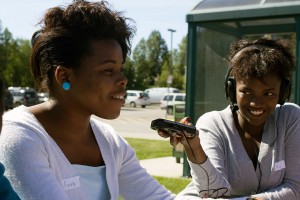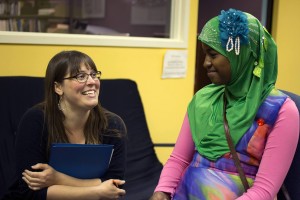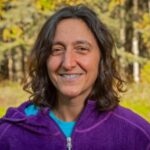
Photos Courtesy of Alaska Teen Media Institute
Everyone has a story to tell, but it may not be the story you’d expect. An Anchorage non-profit called StoryWorks is helping teenagers find their stories, and this summer they focused on students who arrived in the state as refugees.
A group of students and their story-telling mentor lounge on couches at UAA telling each other about their lives.
“Did you learn something from that day?” Rosey Robards asks 17-year-old Furaha Sefania.
Sixteen-year-old Olive Mtoni interjects in Swahili, translating for her new friend. Both girls are originally from the Congo, but Mtoni’s family fled the war-torn nation to Rwanda before she was born. Sefania’s went to Mozambique. They met for the first time at East High in Anchorage late last year. But that’s not the story Sefania has chosen to share…
“Wakati nilikuwa nacheza mpira na rafiki zangu, na mdogo…” Sefania tells her story.
She’s talking about a time when she was 12 years old and playing soccer with her friends back in Mozambique. Her little sister calls her to come eat and she refuses to go. When she finally heads home two hours later, the food is gone. Her sister laughs because she received extra, and her mother admonishes her – if you like soccer so much, than you can eat it! Sefania says she learned to listen to her mother. So why tell this story?
“Niliona tu, tuongee.” She just thought of it when chatting.
And that’s the whole point – stories are just moments to help people understand each other. That’s why 11-year-old Khalil Edais participated in the program. He was born in Anchorage but he loves storytelling and wanted to learn about the other kids.
“A lot of the kids have stories to tell, so this is like a big camp for them because they have big stories from their countries that they told here, so it’s pretty big for me to come here.”
Edais learned about a girl who climbed a tree, was distracted by a monkey, and ended up at the hospital getting shards of wood pulled from her arm. A boy told about the disappointment of leaving home for a cold place but eventually making new friends.
Jessica Kovarik, the program director of Refugee Assistance and Immigration Services, says these stories can help the community understand people from other nations.
“We really wanted to give the youth an opportunity to have some voice and to learn to tell their stories and recognize how powerful their stories are and how much they have to share with the community.”

Twelve-year-old Iqlas Dubed shares the story of her first bee sting – just a month ago, near the Campbell Creek Science Center.
“Then I ran around, ran around, ran around. Then came, I was out of breath, so I was just like ‘It hurts! It hurts!’ And the bee was still on my hijab so I took it off.”
The sting taught her what goes around, comes around. She laughed at other kids who were stung on previous days, then was hurt herself. But telling the story taught her “Don’t be scared to tell others. Other people that you don’t know.”
She said she feels kind of brave now.
RAIS helps resettle about 100 to 140 refugees in Anchorage each year. StoryWorks started in 2014 and teaches high schoolers from around the community to find their voices.
Anne Hillman is the healthy communities editor at Alaska Public Media and a host of Hometown, Alaska. Reach her at ahillman@alaskapublic.org. Read more about Anne here.





